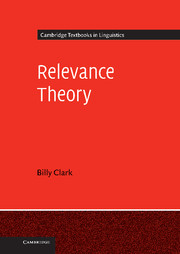Book contents
- Frontmatter
- Contents
- List of Figures and tables
- Preface
- Acknowledgements
- Typographical conventions
- Part I Overview
- Part II Details and developments
- 5 Explicature and implicature
- 6 Types of explicature
- 7 Types of implicature
- 8 Lexical pragmatics
- 9 Figurative language: metaphor
- 10 Figurative language: irony
- 11 Linguistic semantics
- 12 Conclusion: applications and recent developments
- Appendix Key notions of relevance theory
- Notes to chapters
- Bibliography and other resources
- Index
10 - Figurative language: irony
from Part II - Details and developments
Published online by Cambridge University Press: 05 June 2013
- Frontmatter
- Contents
- List of Figures and tables
- Preface
- Acknowledgements
- Typographical conventions
- Part I Overview
- Part II Details and developments
- 5 Explicature and implicature
- 6 Types of explicature
- 7 Types of implicature
- 8 Lexical pragmatics
- 9 Figurative language: metaphor
- 10 Figurative language: irony
- 11 Linguistic semantics
- 12 Conclusion: applications and recent developments
- Appendix Key notions of relevance theory
- Notes to chapters
- Bibliography and other resources
- Index
Summary
Topics: irony as echoic; Grice's traditional approach; irony as pretence; data from other sources
Overview
This chapter begins, in Section 10.2, by presenting the relevance-theoretic account of irony, which sees it as involving echoic use. In Section 10.3, we consider Grice's account, which takes what can be thought of as a traditional view, where ironic utterances are understood to be expressing the ‘opposite’ of what the speaker actually intends. Section 10.4 considers an alternative to the relevance-theoretic view which has its origins in discussion by Grice. On this view, irony is seen as involving a kind of pretence. Finally, Section 10.5 very briefly considers evidence from developmental studies and studies involving subjects with conditions such as autistic spectrum disorders. This evidence suggests that metaphor and irony should be seen as distinct kinds of phenomena.
Irony as echoic
We will now look at and compare three accounts of irony. This time we will approach things from a different direction, beginning with the relevance-theoretic account and then looking at two alternative approaches: Grice’s proposed account which is based on the idea that ironical utterances blatantly violate the maxim of quality and accounts based on the notion of pretence.
- Type
- Chapter
- Information
- Relevance Theory , pp. 280 - 294Publisher: Cambridge University PressPrint publication year: 2013



